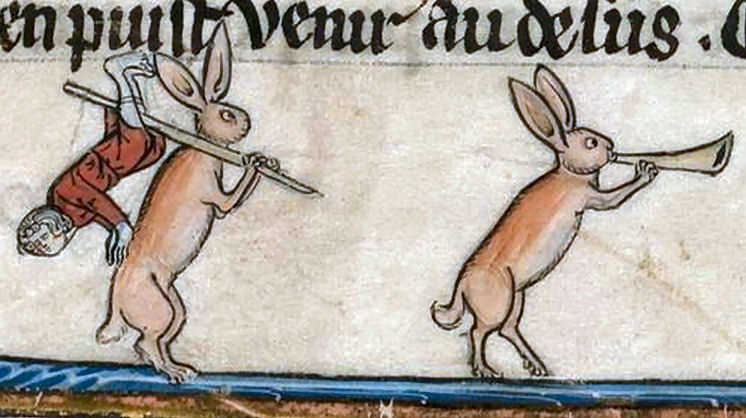
In all the kingdom of nature, does any creature threaten us less than the gentle rabbit? Though the question may sound entirely rhetorical today, our medieval ancestors took it more seriously — especially if they could read illuminated manuscripts, and even more so if they drew in the margins of those manuscripts themselves. “Often, in medieval manuscripts’ marginalia we find odd images with all sorts of monsters, half man-beasts, monkeys, and more,” writes Sexy Codicology’s Marjolein de Vos. “Even in religious books the margins sometimes have drawings that simply are making fun of monks, nuns and bishops.” And then there are the killer bunnies.
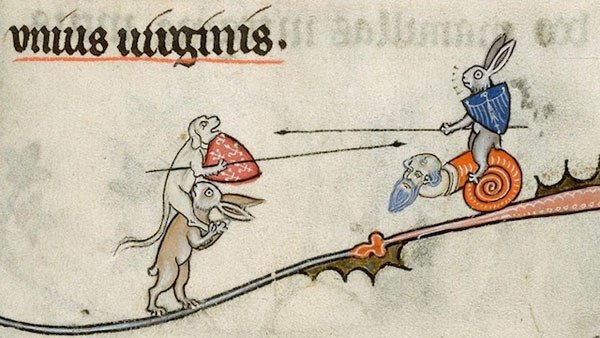
Hunting scenes, de Vos adds, also commonly appear in medieval marginalia, and “this usually means that the bunny is the hunted; however, as we discovered, often the illuminators decided to change the roles around.”
Jon Kaneko-James explains further: “The usual imagery of the rabbit in Medieval art is that of purity and helplessness – that’s why some Medieval portrayals of Christ have marginal art portraying a veritable petting zoo of innocent, nonviolent, little white and brown bunnies going about their business in a field.” But the creators of this particular type of humorous marginalia, known as drollery, saw things differently.
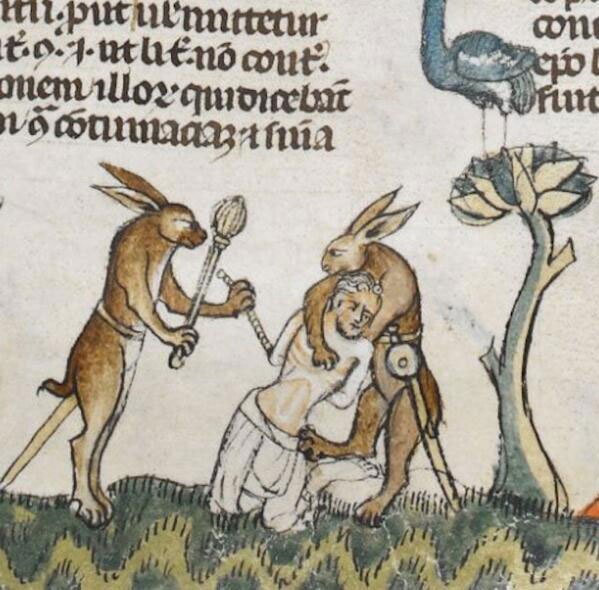
“Drolleries sometimes also depicted comedic scenes, like a barber with a wooden leg (which, for reasons that escape me, was the height of medieval comedy) or a man sawing a branch out from under himself,” writes Kaneko-James.
This enjoyment of the “world turned upside down” produced the drollery genre of “the rabbit’s revenge,” one “often used to show the cowardice or stupidity of the person illustrated. We see this in the Middle English nickname Stickhare, a name for cowards” — and in all the drawings of “tough hunters cowering in the face of rabbits with big sticks.”
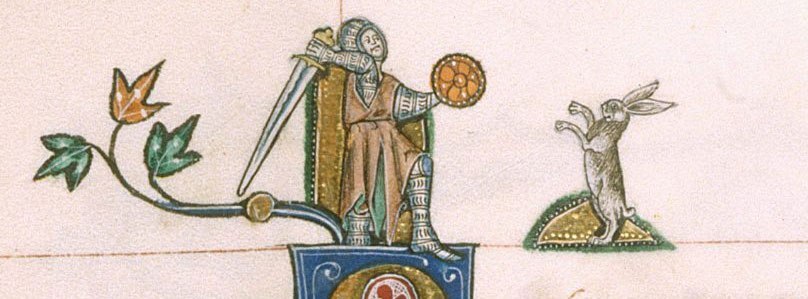
Then, of course, we have the bunnies making their attacks while mounted on snails, snail combats being “another popular staple of Drolleries, with groups of peasants seen fighting snails with sticks, or saddling them and attempting to ride them.”
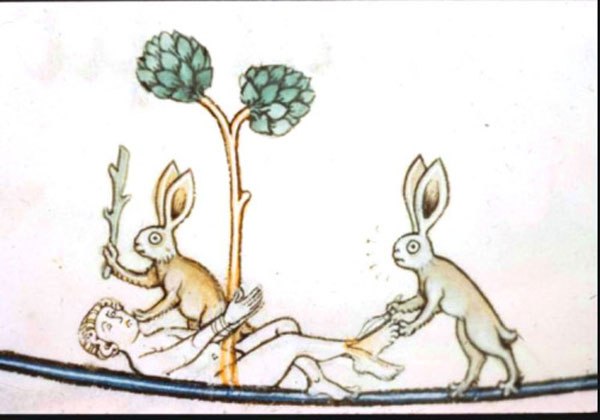
Given how often we denizens of the 21st century have trouble getting humor from less than a century ago, it feels satisfying indeed to laugh just as hard at these drolleries as our medieval forebears must have — though many more of us surely get to see them today, circulating as rapidly on social media as they didn’t when confined to the pages of illuminated manuscripts owned only by wealthy individuals and institutions.
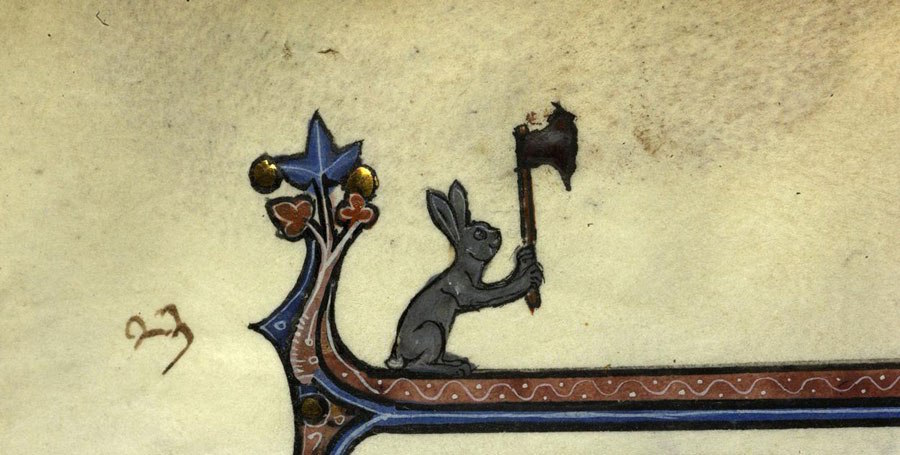
You can see more marginal scenes of the rabbit’s revenge at Sexy Codicology, Colossal, and Kaneko-James’ blog. But one historical question remains unanswered: to what extent did they influence that pillar of modern cinematic comedy, Monty Python and the Holy Grail?
Related Content:
Explosive Cats Imagined in a Strange, 16th Century Military Manual
Based in Seoul, Colin Marshall writes and broadcasts on cities, language, and culture. His projects include the book The Stateless City: a Walk through 21st-Century Los Angeles and the video series The City in Cinema. Follow him on Twitter at @colinmarshall or on Facebook.


I find them quite Bugs Bunny-ish…
“a barber with a wooden leg” — funny to the medieval mind if back then it was the barbers who performed amputations, as I’ve heard. An amputated barber who then inflicts the same horror on another? Darkly funny!
Barber-surgeons were common in the middle-ages, the body of one such individual dating from the 14th Century was discovered in 1938 underneath one of the stones in the Avebury stone circle in Wiltshire, England. It seems he was among the group of people engaged in toppling the stones when it fell on top of him. As those stones can weigh up to nearly 100 tonnes, it proved fatal!
Regarding the ‘bunnies’, I believe that the drawings depict hares, which were considered a much darker, more threatening creature; the fact that one is drawn in a pose like a boxer facing up to an armoured Knight is suggestive of the behaviour of hares in March, where female hares will stand and box with prospective mates, often quite violently.
The rabbit carrying a shield and lance, riding a snail with a human face begs the question: did Jay Ward know about this before he created Crusader Rabbit in 1950, thus creating the first animated for television cartoon series. (He had much better success with his second series Rocky & Bullwinkle. June Foray did the voices for both Crusader and Rocky.)
Tweet John, Michael, and Eric while you can! Complete the research!!!
since barbers were surgeons in the past, a barber with a woodden leg means surgery was done to the surgeon, he had to endure what he did to others, and survived .
Seems likely. Marginalia is a well-researched area of academia. Even a Bachelor’s-level English major is exposed to some small analysis of it.
This sounds like the joke.
http://www.stewarthendrickson.com/songs/BawdyBroadsides/WoodenLegParson.html
I wondered if the Rabbit of Caerbannog would come into play …
Barber-surgeons were common until at least the mid-19th century. Before that, surgeons with medical degrees were the exception, not the rule.
Given Terry Jones’ extensive passion for researching and writing about Medieval literature, I’d say it’s almost certain that margin bunnies form part of the inspiration for the killer rabbit.
There’s even game about it in the making
https://twitter.com/YazaGames/status/1114147020003061762?s=20
La imagen del conejo, en sentido simbólico del Tarot (para algunas interpretaciones de arquetipos) representa los deseos insatisfechos. Desde esta premisa, puede leerse a la víctima, cazador o simple humano, como “torturado”, atrapado por y en ello. Desconozco si era el propósito que daba el ilustrador en cada caso y lo comento a manera de cultura general.
It may be that the peg-leggrd barber struck the medevial funny bone so hard is that barbers doubled as surgeons who performed limb amputations.
Perhaps the barber joke is that the barber-surgeon amputated the wrong limb by accident (always a risk) — his own!
Anya was F’ing right, it’s Bunnies!
Barbers used to serve as the first “surgeons.” Hence, the irony of a barber having a wooden leg!
Other cinematic rabbit roles include DONNIE DARKO and THE NIGHT OF THE LEPUS!
Killer rabbits are pretty dangerous, those bastards can eat you alive, inside out. The great one is the most dangerous.
Yes, I agree with your two points.
Can anyone find among these manuscripts an image showing a woman with a rabbit? If there is one, it’s extremely rare. That’s because the rabbits ARE the women, or monastic code for women. Conny/Cunny. These images show men “virtuously” combatting the “thralls” of women, multitudes of whom ended up burned at the stake.
That, Pyat, is fascinating. So in Holy Grail, the killer rabbit and the women of Castle Anthrax are equivalent.
In one of the precursors of Monty Python (I’m Sorry I ‘ll Read that Again) there is a “Vampire Rabbit” sketch which is an open dig against David Frost. So … Rabbits are funny.…